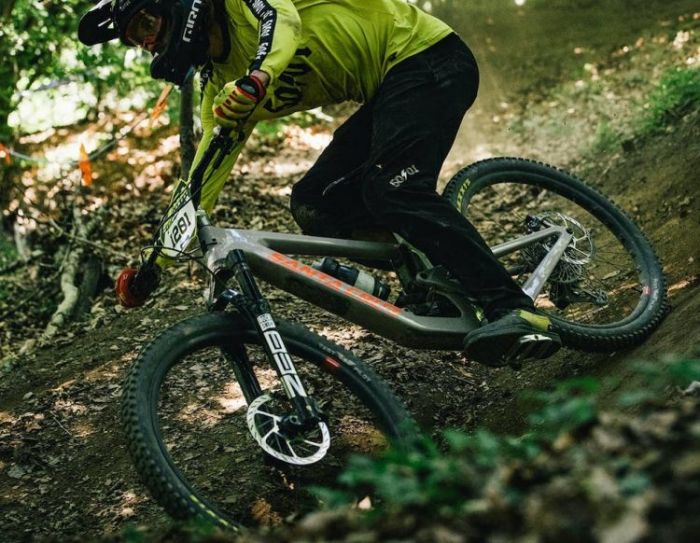Trek Procaliber 9.6
- Price: $3099.99
- Frame: OCLV Mountain Carbon Fiber
- Fork: RockShox Recon Gold RL
- Gears: 1×12 speed
- Tires: 29×2.40″ (max)
What we like about it: Lightweight and strong carbon frame make for a sturdier body, while the smooth IsoSpeed splitter makes for the ultimate speed experience at every xc race.
What we don’t like: The lack of dropper post and the mediocre geometry.
Rating: (4.6/5)
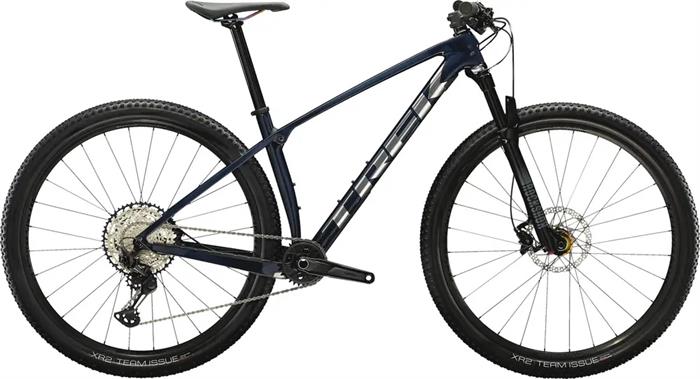
As a mountain biker, you can’t have not heard of the Trek Procaliber 9.6, which is one of the most popular products among cyclocross racers, and is equipped with accessories that are tailor-made for xc racing.
Under the OCLV Mountain Carbon carbon fiber shell, the Trek Procaliber 9.6 has a lighter yet sturdier body that can handle all the surprises of mountain bike racing. Not only that, but even without the added benefit of a rear shock, the Trek procaliber 9.6 doesn’t compromise on damping and comfort.
The extra technology involved with IsoSpeed adds a few grams to the frame weight, but Trek still manages to produce the lightest bike in the test. Even if it’s only 110 grams lighter than its closest competitor, the Mondraker Chrono Carbon R, it has much more aggressive damping effectiveness.
At the same time, the wide, thick 29×2.40″ tires have the speed and ultimate stability to get you to the top of the mountain race.
Below we break down the descending and climbing performance, key features, components, and specifications of the Trek procaliber 9.6, as well as the other versions in the series. To see how it stacks up, see our article on the best mountain bikes.
Climbing

The light but strong carbon fiber material gives it an advantage over aluminum alloys for racing conditions. Especially in xc races, the rolling of mud and rocks, and the piling up of hills and stones place higher demands on the bodywork. Of course, the performance of Trek procaliber 9.6 is satisfactory.
The Trek procaliber 9.6, our team’s main character, was tested on a surface that was well matched to the xc course to see if its climbing performance could meet my expectations.
We rode about 5km on a rugged two-track road in the mountains and forests, which was one of my practice tasks today. There were 16 hills with steep angles, and each climb had countless chunks of debris and thorny branches of dead vines.
My first concern was whether the Trek procaliber 9.6 tires would be able to cope with these complicated road conditions. The Bontrager XR2 tires were indeed a powerful weapon on these surfaces (120 tpi, 29×2.20”), and the strong, rough surface gave me great confidence on the ascent.
Whenever I climbed, it’s no exaggeration to say that I didn’t feel too much loss of air power, which is probably related to my years of experience on the trail.
But at the same time, I think it’s the Trek procaliber 9.6’s fault that the looser seat tube angle allows my body weight to be distributed effectively.
Meanwhile, the fast-rolling 29er wheels and RockShox Recon Gold RL suspension fork kept me extremely fast on the uneven gravel roads. I accelerated for a period of time, and the pedals gained some momentum, allowing me to keep my legs still while reaching the summit crest a few miles from the top.
Descending
Of course, we have to admit that the Trek Procaliber 9.6 is an efficient downhill sprinter. We are very fond of the longer downhill roads in off-road terrain because of the gravel and coiled roots with rhythmic vibrations on the road.
As a hardtail bike, it naturally has no rear suspension, and some might question whether its damping effectiveness will therefore become unbearable. I’d say such concerns are completely unnecessary with the Trek Procaliber 9.6.
The 100mm of front travel may not be what one would expect, but I was pleasantly surprised by the IsoSpeed fitted to the Trek Procaliber 9.6 in our actual test.
When returning along the same road, we were bound to pass through the same intersection, with the inevitable swap between uphill and downhill. I didn’t feel too much shaking on the downhill descent, instead, it was more relaxed and well within the range of my body.
The extra technology involved with the IsoSpeed adds a few grams to the frame weight, but the Trek’s dedication to the bike’s weight is still unmatched. It’s only 110 grams lighter than its closest competitor, the Mondraker Chrono Carbon R.
Inevitably, mountain riding will encounter rocky and bumpy surfaces, perhaps not a big challenge for a pro racer, and by lifting the bike we can quickly break through these obstacles. Of course, without the weight of the rear suspension, Isospeed made it easier for me to lift the bike, ensuring that the entire trip was efficient.
The bike is efficient, with enough 1×12 powershift for my road needs on different surfaces. In this respect, I have high expectations for it in the next XC races.
Main Features
Trek Procaliber 9.6 Frame
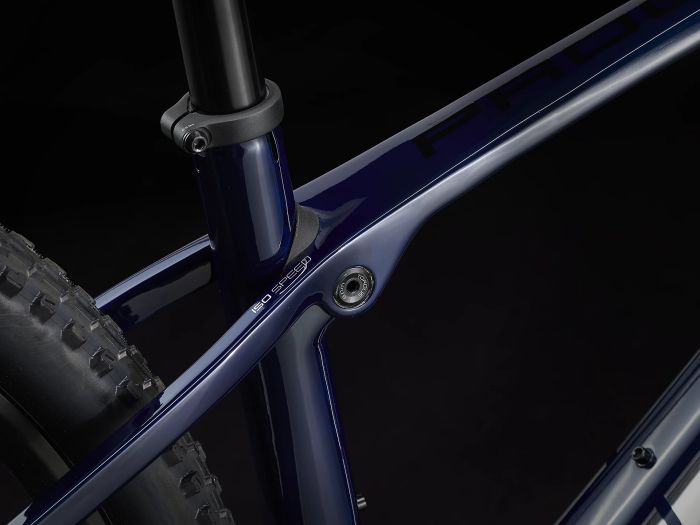
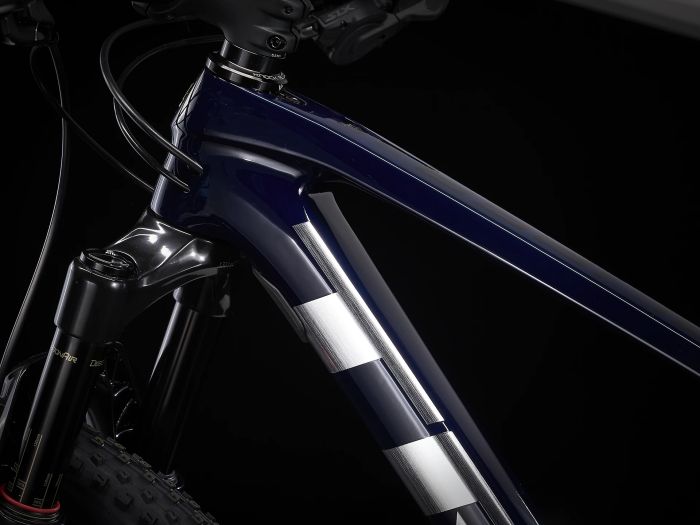
The manufacture of carbon fiber may also be the choice of mountain bikes today, precisely because its high-quality and hard shell is also excellent, and the extreme toughness under the laminate also makes the body extremely light.
The artistic combination of transmission, brake, and locking will leave a deep impression on the appearance, and the reduction of the rear shock absorber involves simplifying the body structure, thus making it more aesthetically experienced by simple lovers. If you’re a carbon fiber lover, maybe you can try it.
Moreover, as a feature of the Trek Procaliber 9.6, the active 5G IsoSpeed brings great simplicity to the body, with luxurious DebonAir springs and a double guarantee under the remote locking to make you feel much less fatigue during the journey. The upgraded fork gives you remote locking, more luxurious springs, and dampers that give you more control over the rough stuff.
At the same time, the ultra-rigid direct downtube responds to responsive operation without adding additional weight, while the knock Block headset also prevents the rod from rotating inadvertently. I’m happy with that.
Of course, like other bikes, the Procaliber 9.6 can be added to the right water bottle in the downtube area according to your preferences at each size to ensure that you have plenty of moisture during the trip.
Geometry
It has to be admitted that the Trek Procaliber 9.6 has not made a major breakthrough in geometry, still maintaining a decent size.
The 68.8 head tube angle is still a good size in the ranks of the entire bike, and personally, 68-73° will be of great help to my race, and the angle that is too loose or steep may have a certain sense of obstacle to my sprint.
Compared to the same type of off-road vehicle, the Trek Procaliber 9.6 has a relatively short front and rear wheelbase (1,103), of course, this is not absolutely right or wrong, the short wheelbase will help maintain more sensitive steering under the sharp corners, which is of great significance in my cornering overtaking.
Shimano SLX M7100
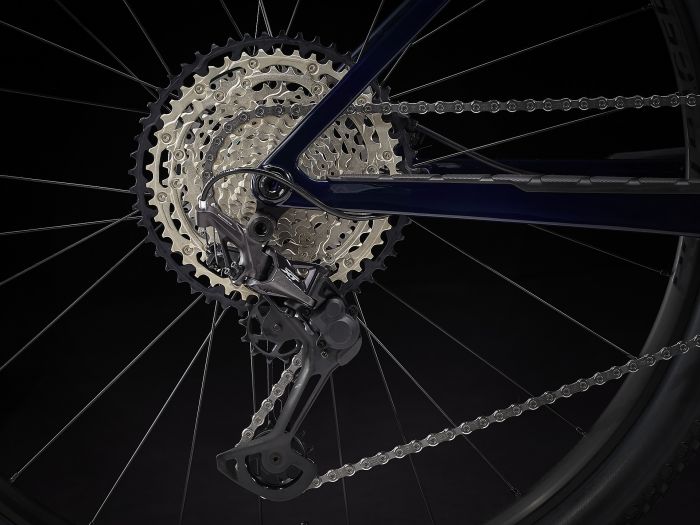
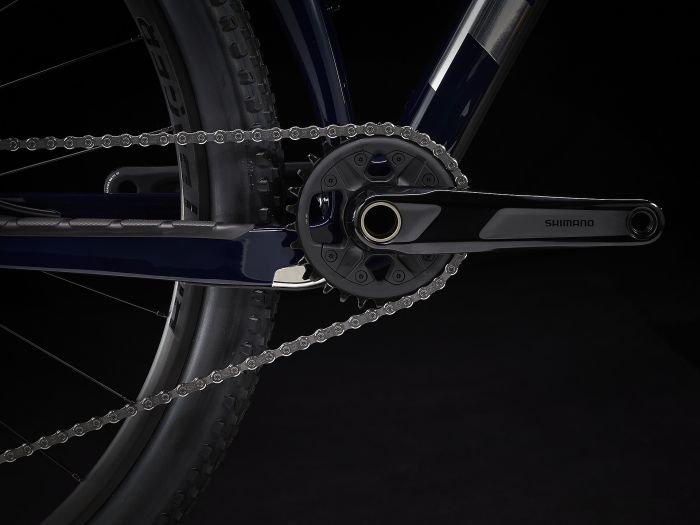
The Trek Procaliber 9.6 still has an absolute advantage in terms of transmission, and it’s Shimano SLX M7100 plays an extremely important role in your journey of more than ten kilometers.
The 1×12 spec is standard on mountain bike buggies, but for me, that may not be enough, I personally have a very sensitive perception of the speed of the buggy, I prefer it to have a higher and higher number of flywheels, of course, just for me.
But I have to admit that the Shimano SLX M7100 has a certain discount on the price, equipped with SLX using trickle technology and the advantages of XT and XTR group, smooth and precise shifting, Shimano SLX M7100 in which the position of the core, clean, smooth appearance, giving people a sense of sharpness. This may also be the innate wildness of mountain biking.
The Shimano SLX M7100 gives the Trek Procaliber 9.6 a head start in its class, so if you want to gain an edge in the XC race, give it a try.
Tire
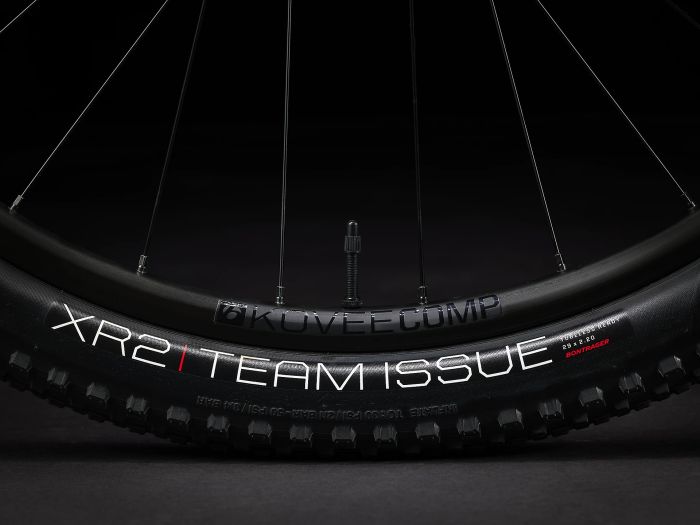
In terms of tire size, the Trek Procaliber 9.6 originally comes with a 29×2.20”’ outfit. In terms of width, it doesn’t meet the requirements for everyday off-road riding.
So I got in touch with the dealer and changed it to a 2.4-inch-wide tire (its maximum tire width was 2.4 inches) which was a big improvement on my ride.
Wider and thicker tires can still maintain a tight grip as I take off from the rocky woods, and the 120tpi parameter specification can also meet the riding requirements to the maximum. Ditching the inner tube and adopting a tubeless Bontrager will help you get the best performance out of your tires. There are no tubes to clamp, so you can run at lower pressure for better traction and get more control and a smoother, faster ride on a rugged mountain ride.
Isospeed
The lightweight and sturdy carbon fiber of Trek Procaliber 9.6 has reduced body quality to unprecedented standards, which is what Trek has always pursued.
After the cancellation of the rear suspension, the mass of the body was also greatly released. At the same time, the task of damping is left to isospeed, a small part weighing up to 5 grams, while the 100mm RockShox Recon Gold RL fork with luxurious DebonAir springs and remote locking makes the bike extremely stable in the rocky woods, which greatly reduce the intense shock caused by the impact on the ground and the body during driving.
Shimano hydraulic Disc Brake
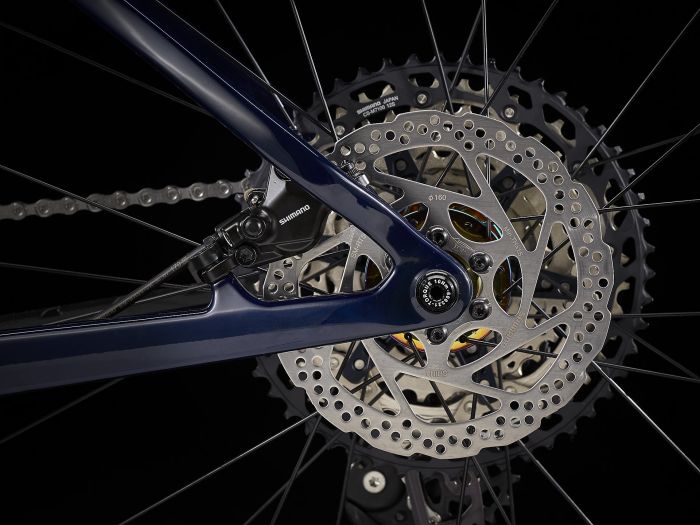
Shimano has a unique track record in braking, with its responsive and fast braking capabilities often allowing you to achieve the ultimate in the event of emergency hazards.
The Trek Procaliber 9.6 front and rear wheels are equipped with Shimano RT56 bolt disc brake discs to provide consistent braking force in all riding conditions. The new fastening plate construction enables fast and safe installation.
After two days of sprint experimentation, although it was really exhausting. We found that the Shimano RT56 was able to brake more safely and efficiently on steep and rugged hills. There was some delay, it was still within the acceptable range.
The process was thrilling, but every time I experimented with the Shimano RT56, the dual-piston braking allowed me to drive smoothly and safely to the ground, which gave me confidence in the Trek Procaliber 9.6 in the next XC race.
Other Versions of Trek Procaliber 9.6
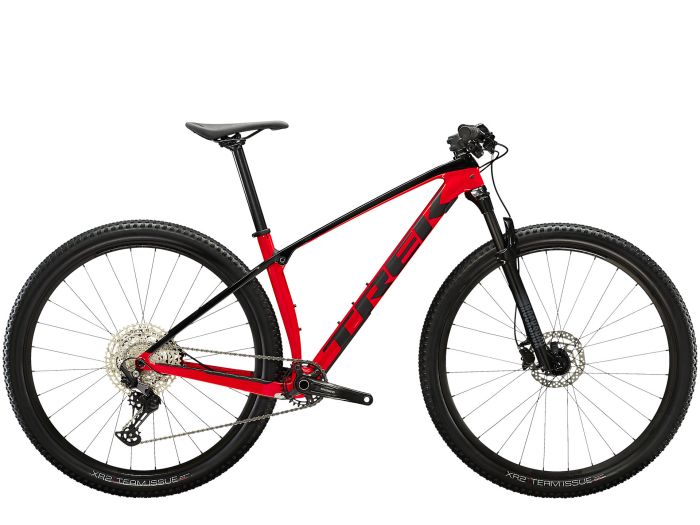
For comparison, we also examined other versions of Procaliber, including Procaliber 9.5, the previous generation of Procaliber.
Also as a lightweight carbon fiber hard-tail vehicle, ISOspeed parts will not be too heavy under the equipment, and the speed and function presented on the monorail speed track are still excellent.
However, the RockShox Judy SL fork under the 1×12 drivetrain may be slightly inferior to the Trek Procaliber 9.6. At the same time, the Shimano Deore M6100 equipped with Procaliber 9.5 is a little slower than the Shimano XT M8100 in gear shifting, which is also the most intuitive feeling of riding on two bicycles these days.
Of course, if you are a novice on the bike, perhaps such a point requirement is not as strong as you feel. You can also try Procaliber 9.5 because its price advantage is still more obvious.
Learn More: Great Value Carbon Hardtail Bike – Trek Procaliber 9.5 Review
What do we like about it?
- Carbon fiber material presents a lightweight shell.
- The control ability of the luxurious spring damper is excellent.
- ISOPEED replaces the rear suspension to reduce body weight while increasing stability.
- The small, lightweight direct downtube makes the operation more sensitive.
What don’t we like about it?
- Expensive accessory prices.
- Not outstanding geometry.
FAQs
- What is the body material of Trek Procaliber 9.6?
Trek Procaliber 9.6 is made of carbon fiber.
- How much does Procaliber9.6 cost?
The official price for Procaliber9.6 is $3099.99.
- What is the maximum tire size for Trek Procaliber 9.6?
The maximum size that Trek Procaliber 9.6 can accept is 29×2.40″.
Specs
Frameset
| Frame | OCLV Mountain Carbon, IsoSpeed, tapered head tube, Knock Block, internal control routing, balanced post mount brake, Boost148 |
|---|---|
| Fork | RockShox Recon Gold RL, DebonAir spring, Motion Control damper, remote lockout, tapered steerer, 42mm offset, Boost110, 15mm Maxle Stealth, 100mm travel |
| Suspension lever | RockShox OneLoc Sprint |
| Max compatible fork travel | 120mm (533 axle-to-crown) |
Wheels
| Wheel front | Bontrager Kovee Comp 23, Tubeless Ready, 6-bolt, Boost110, 15mm thru axle |
|---|---|
| Wheel rear | Bontrager Kovee Comp 23, Tubeless Ready, Shimano Microspline freehub, Rapid Drive 108, Boost148 |
| Hub front | Bontrager sealed bearing, alloy axle, 6-bolt, Boost110, 15mm thru axle |
| Skewer rear | Bontrager Switch thru axle, removable lever |
| *Rim | Size: S , M , ML , L , XL , XXL Bontrager Kovee Comp 23, Tubeless Ready, 6-bolt, Boost110, 15mm thru axle Size: S , M , ML , L , XL , XXL Bontrager Kovee, double-wall, Tubeless Ready, 28-hole, 23mm width, presta valve |
| Tire | Bontrager XR2 Team Issue, Tubeless Ready, Inner Strength sidewall, aramid bead, 120 tpi, 29×2.20” |
| Tire part | Bontrager TLR sealant, 6oz |
| Rim strip | Bontrager TLR |
| Max tire size | Frame: 29×2.40″ Fork: See manufacturer |
Drivetrain
| Shifter | Shimano SLX M7100, 12 speed |
|---|---|
| Rear derailleur | Shimano XT M8100, long cage |
| *Crank | Size: S Shimano MT611, 30T steel ring, alloy spider, 52mm chainline, 170mm length Size: M , ML , L , XL , XXL Shimano MT611, 30T steel ring, alloy spider, 52mm chainline, 175mm length |
| Bottom bracket | Shimano MT500, 92mm, PressFit |
| Cassette | Shimano SLX M7100, 10-51, 12 speed |
| Chain | Shimano Deore M6100, 12 speed |
| Max chainring size | 36T, Min 30T |
Components
| Saddle | Bontrager Arvada, hollow chromoly rails, 138mm width |
|---|---|
| *Seatpost | Size: S Bontrager Comp, 6061 alloy, 31.6mm, 8mm offset, 330mm length Size: M , ML , L , XL , XXL Bontrager Comp, 6061 alloy, 31.6mm, 8mm offset, 400mm length |
| *Handlebar | Size: S , M , ML Bontrager Comp, alloy, 31.8mm, 5mm rise, 720mm width Size: L , XL Bontrager Rhythm Comp, alloy, 31.8mm, 15mm rise, 750mm widthSize: XXL Bontrager Line, alloy, 35mm, 15mm rise, 750mm width |
| Grips | Herrmans Clik |
| *Stem | Size: S , M Bontrager Rhythm Comp, 31.8mm, Knock Block, 0 degree, 60mm length Size: ML Bontrager Rhythm Comp, 31.8mm, Knock Block, 0 degree, 70mm length Size: L , XL Bontrager Rhythm Comp, 31.8mm, Knock Block, 0 degree, 80mm length Size: XXL Bontrager Elite, 35mm, 0 degree, 90mm length |
| Headset | Knock Block Integrated, 62-degree radius, cartridge bearing, 1-1/8” top, 1.5” bottom |
| Brake | Shimano hydraulic disc, MT4100 lever, MT410 caliper |
| *Brake rotor | Size: S , M , ML , L , XL , XXL Shimano RT56, 6-bolt, 180mm Size: S , M , ML , L , XL , XXL Shimano RT56, 6-bolt, 160mm |
Weight
| Weight | M – 11.43 kg / 25.21 lbs (with TLR sealant, no tubes) |
|---|---|
| Weight limit | This bike has a maximum total weight limit (combined weight of bicycle, rider, and cargo) of 300 pounds (136 kg). |
Comparison Table
| BIKE | PRICE | DRIVETRAIN | TIRE | Front Fork | CLICK VIEW |
| Scott Scale 925 | $2,999 | 1X12 | 29″ | 100mm | Click View |
| Niner AIR 9 RDO 2-STAR SRAM SX EAGLE | $3,149 | 1X12 | 29″ | 100mm | Click View |
| Santa Cruz CHAMELEON R / AL / MX | $3,199 | 1X12 | 29“ / 27.5” | 130mm | Click View |
| Canyon Lux World Cup CF 6 | $3,999 | 1X12 | 29″ | Front 100mm Rear 100mm | Click View |
Trek Procaliber9.6 vs Scott Scale 925
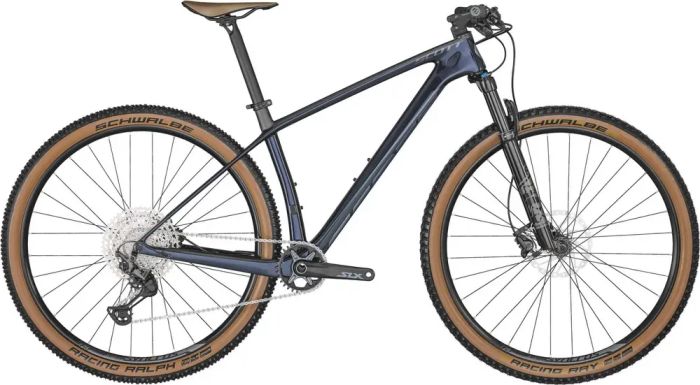
The Procaliber 9.6 and the Scott Scale 925 are very similar in many ways, including a similar weight ratio, and the same carbon fiber body frame. If you are a fan of carbon fiber, you can also pay attention to it.
However, there are some differences in some aspects. Procaliber 9.6 uses carbon fiber in the selection of wheels, while Scott Scale 925 uses aluminum in terms of wheels, so the former can absorb more energy when driving on bumpy roads. A lot of vibration is used to slow down the grief caused by the collision between the earth and the body on the body.
Geometrically, the two cars still maintain a lot of similar designs. But the Procaliber 9.6 has a longer-range wheelbase, which could be controversial. Personally, I prefer the longer wheelbase presentation because I can maintain a better mass distribution during daily riding.
In terms of fork choices, the two still have very distinctive choices. Scott Scale 925 chose FOX 32 Float Rhythm Grip 3 3. I also tried to compare the two cars on the same road section, with the same front fork of 100mm Procaliber9. 6 has a better performance perhaps because of the unique isospeed. Especially since the price difference between the two cars is similar, I prefer to recommend Procaliber 9.6 to you.
Learn more :Is the Scott Scale 940 A Great Value Hardtail Bike? [Scott Scale 940 Review]
Trek Procaliber 9.6 vs Niner AIR 9RDO2-STAR SRAM SX EAGLE
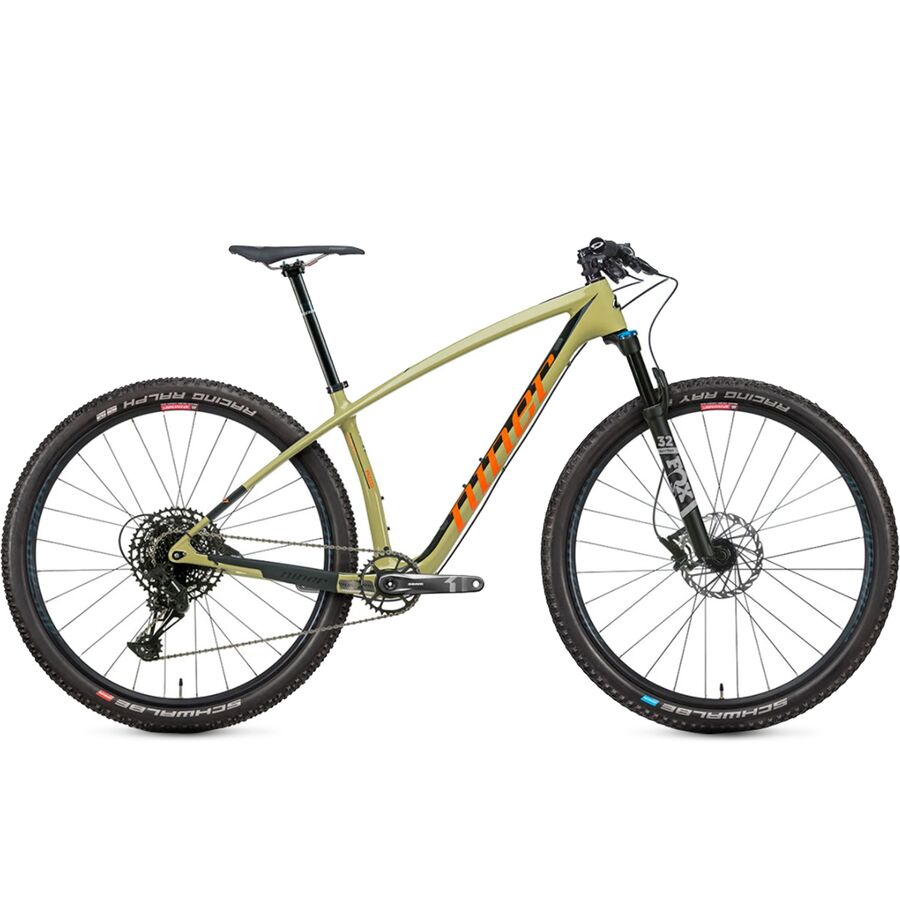
Also under the carbon fiber exterior bracket, unlike Trek procaliber 9.6, the Niner AIR 9 RDO 2-STAR SRAM SX EAGLE has a lighter weight (10.9 kg) which also allows you to lift it with less effort when you encounter roads where you can’t bike.
In terms of the choice of fork, the Niner AIR 9 RDO 2-STAR SRAM SX EAGLE it chose the Scott Scale 925 similar to Fox Rhythm Float 32, which still doesn’t feel as smooth as Procaliber 9.6, of course, you may not be able to feel it, but it is quite obvious to my perennial xc riders. Also as a hard-tailed bike, the Procaliber 9.6 still has ISOSPEED to make up for it without the blessing of the rear shock absorber.
The Niner AIR 9 RDO 2-STAR SRAM SX EAGLE on brakes is an SRAM that has an easier to-follow, lightest off-road braking model on braking while having more feel and modulation, no matter what category of brakes we’re talking about. The lever feels smooth and you can slowly apply the desired braking pressure in any given situation.
Of course, you can also make the right choice according to your own needs, I personally prefer Shimano, I enjoy the emergency brake it brings me the ultimate installation feeling.
Learn more : Is Niner AIR 9 2-STAR SRAM SX EAGLE Splendid? – [Review]
Trek Procaliber 9.6 vs Santa Cruz CHAMELEON R / AL / MX
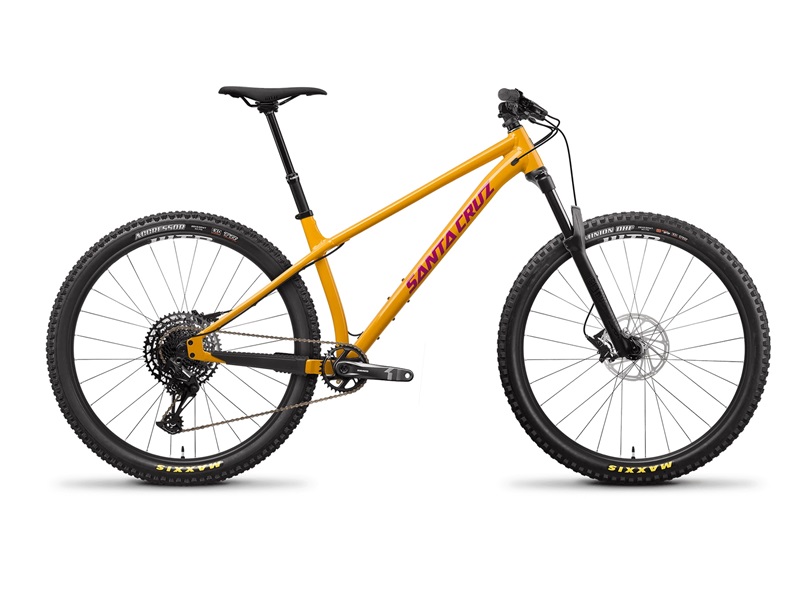
In terms of body manufacturing materials, Santa Cruz CHAMELEON R / AL / MX did not choose the popular carbon fiber structure on the market but chose a more robust aluminum material, of course, it has a cheaper price, as well as a more maintainable body structure. Until now, there are still many people surrounding it.
Not only that, in the choice of wheels, it is still mainly made of aluminum materials, which may not bring a light feeling to the number of cars in the bumps of the mountain, and the shock feeling brought by fox Rhythm Float 34 still has a different feeling than RockShox Recon Gold RL, and the 130mm stroke may make up for such a defect. Riding experience doesn’t make a huge difference in actual riding.
Geometrically, Santa Cruz CHAMELEON R/AL/MX has a stronger wheelbase length (1207.8) and a relatively longer body that maintains safer stability on rugged mountainous roads. In terms of tire selection, Santa Cruz CHAMELEON R/ AL / MX can choose a smaller (27.5″) tire size, so it compensates for the overly long steering insensitiveness of the body, not only that, but on smooth roads, lighter tires allow you to accelerate faster, especially for the last few hundred meters of the race.
Learn more :Is Santa Cruz CHAMELEON A Good Bike? [Santa Cruz CHAMELEON Review]
Trek Procaliber 9.6 vs Canyon Lux World Cup CF 6
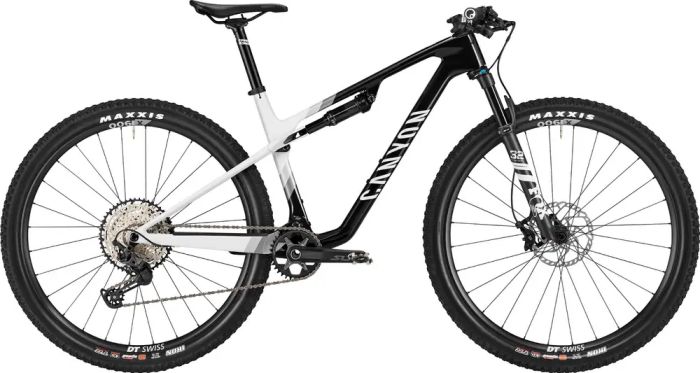
Compared to the Trek Procaliber 9.6, the Canyon Lux World Cup CF 6 has a heavier body (12.1kg) and a more expensive price ($3,999), and of course, it has better accessories for a penny.
First of all, it is not the hard-tail bike we mentioned, on the contrary, it is a full suspension off-road bike, with front and rear travel of 100mm, although such a number of strokes is not the best in its kind of full suspension model. However, it still has a more effective shock absorption system than the hardtail.
Of course, it also means heavier body weight, which may not be so fast at speed, if the front and rear double locks, then the body will become very stiff, as far as I am concerned, I don’t like this feeling,
In terms of geometry, because the already bulky volume has brought about a reduction in the center of gravity, it has a relatively high lift in the center of the BB, which is also within the accepted range.
If your goal is full suspension, you still have to make more range of choices, and if your goal is only a hardtail, I believe Procaliber 9.6 will be more in line with your expectations.
In case, the above comments are helpful to you, please remember to share the subscription. Have a great day!
Learn more :
Is Canyon Lux Trail CF 7 Worth Buying? [Canyon Lux Trail CF 7 Review]
Top 10 Best Hardtail Mountain Bikes – For Different Budgets

![[Orbea URRUN 10 20mph Review] – Best Used By People Who Enjoy Riding To Get AFeel For The Mountains!](https://bestbikeselect.com/wp-content/uploads/2023/09/2023-Orbea-URRUN-10-20mph-35_-1024x1024.jpg)
![[Specialized Turbo Como 5.0 Review] – Good Choice?](https://bestbikeselect.com/wp-content/uploads/2023/08/2023-Specialized-Turbo-Como-5.01_-1024x1024.webp)
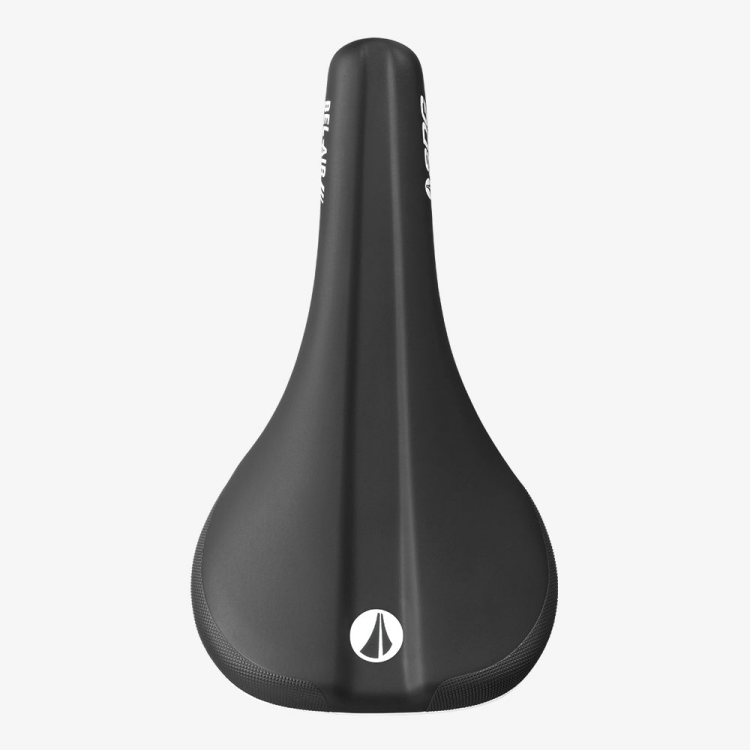
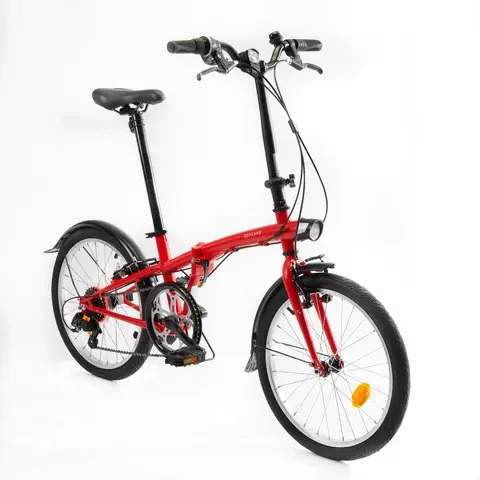
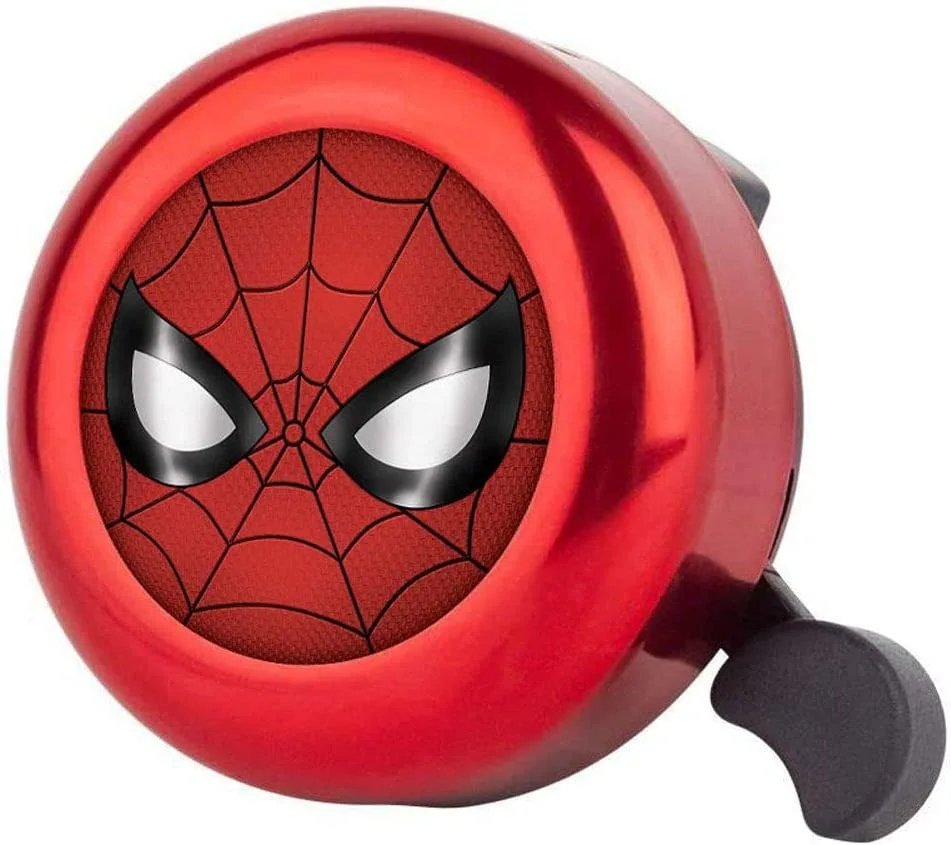
![2025 Built for Champions:[Orbea ORCA M21eTEAM PWR Review]](https://bestbikeselect.com/wp-content/uploads/2025/01/ORCA-M21eTEAM-PWR-1024x885.jpg)
![2025 Conquer Any Trail [Santa Cruz Bronson R Review]](https://bestbikeselect.com/wp-content/uploads/2025/01/Santa-Cruz-Bronson-R-1-1024x768.webp)
![2025 The All-Terrain Beast [Santa Cruz Hightower 3 MY24 Review]](https://bestbikeselect.com/wp-content/uploads/2025/01/Santa-Cruz-Hightower-3-MY24-1024x768.webp)
![The Best Comfortable Leisure Bike of 2025 [ Trek Verve 2 Lowstep Gen 5 ]](https://bestbikeselect.com/wp-content/uploads/2024/12/Verve-2-Lowstep-Gen-5-02-1024x681.png)
![2025’s Top Endurance Bikes [Cannondale Synapse Carbon 3 L Review]](https://bestbikeselect.com/wp-content/uploads/2025/01/Cannondale-Synapse-Carbon-3-L-1-1024x627.webp)
